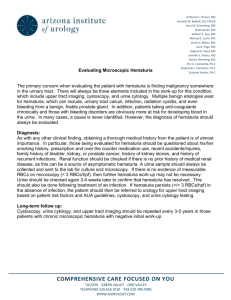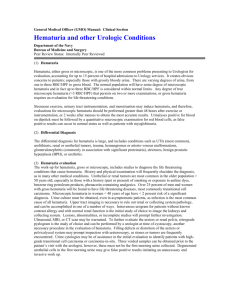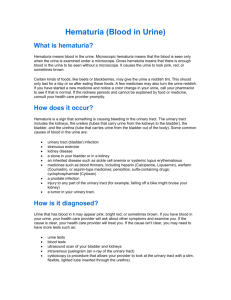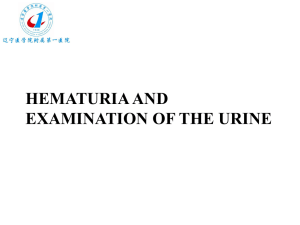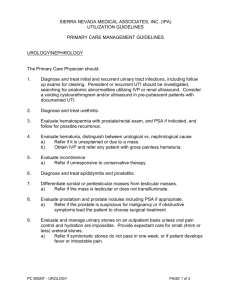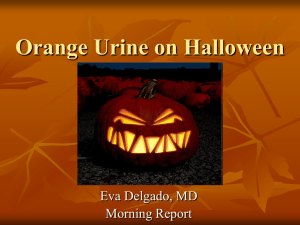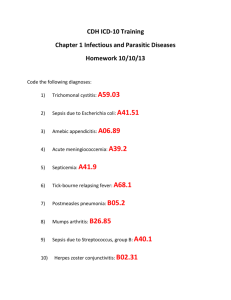Page 1 of 14 3/13/2006 http://www.utdol.com/utd/content/topic.do
advertisement
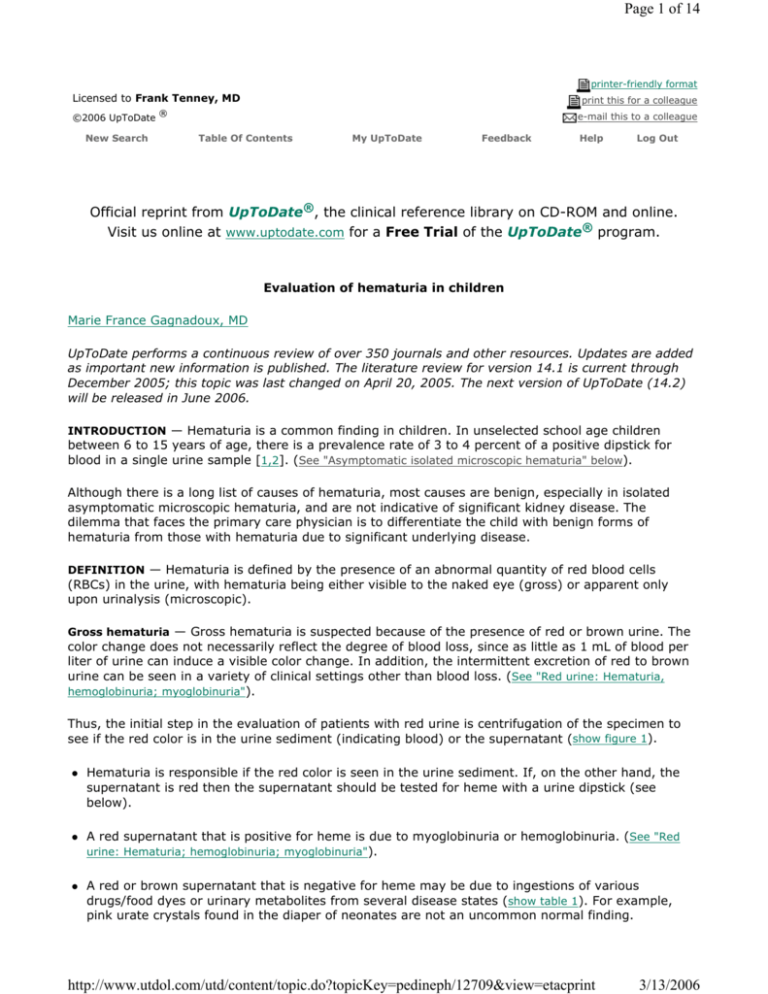
Page 1 of 14 printer-friendly format Licensed to Frank Tenney, MD print this for a colleague ©2006 UpToDate ® New Search e-mail this to a colleague Table Of Contents My UpToDate Feedback Help Log Out Official reprint from UpToDate®, the clinical reference library on CD-ROM and online. Visit us online at www.uptodate.com for a Free Trial of the UpToDate® program. Evaluation of hematuria in children Marie France Gagnadoux, MD UpToDate performs a continuous review of over 350 journals and other resources. Updates are added as important new information is published. The literature review for version 14.1 is current through December 2005; this topic was last changed on April 20, 2005. The next version of UpToDate (14.2) will be released in June 2006. INTRODUCTION — Hematuria is a common finding in children. In unselected school age children between 6 to 15 years of age, there is a prevalence rate of 3 to 4 percent of a positive dipstick for blood in a single urine sample [1,2]. (See "Asymptomatic isolated microscopic hematuria" below). Although there is a long list of causes of hematuria, most causes are benign, especially in isolated asymptomatic microscopic hematuria, and are not indicative of significant kidney disease. The dilemma that faces the primary care physician is to differentiate the child with benign forms of hematuria from those with hematuria due to significant underlying disease. DEFINITION — Hematuria is defined by the presence of an abnormal quantity of red blood cells (RBCs) in the urine, with hematuria being either visible to the naked eye (gross) or apparent only upon urinalysis (microscopic). Gross hematuria — Gross hematuria is suspected because of the presence of red or brown urine. The color change does not necessarily reflect the degree of blood loss, since as little as 1 mL of blood per liter of urine can induce a visible color change. In addition, the intermittent excretion of red to brown urine can be seen in a variety of clinical settings other than blood loss. (See "Red urine: Hematuria, hemoglobinuria; myoglobinuria"). Thus, the initial step in the evaluation of patients with red urine is centrifugation of the specimen to see if the red color is in the urine sediment (indicating blood) or the supernatant (show figure 1). z Hematuria is responsible if the red color is seen in the urine sediment. If, on the other hand, the supernatant is red then the supernatant should be tested for heme with a urine dipstick (see below). z A red supernatant that is positive for heme is due to myoglobinuria or hemoglobinuria. (See "Red urine: Hematuria; hemoglobinuria; myoglobinuria"). z A red or brown supernatant that is negative for heme may be due to ingestions of various drugs/food dyes or urinary metabolites from several disease states (show table 1). For example, pink urate crystals found in the diaper of neonates are not an uncommon normal finding. http://www.utdol.com/utd/content/topic.do?topicKey=pedineph/12709&view=etacprint 3/13/2006 Page 2 of 14 Microscopic hematuria — Microscopic hematuria may be discovered as an incidental finding on a routine urinalysis or by urinalysis prompted by urinary or other symptoms. The most common screening test for hematuria is the dipstick test for blood. The reagent strip utilizing hydrogen peroxide catalyzes a chemical reaction between hemoglobin (or myoglobin) and the chromogen tetramethylbenzidine. Different shades of blue-green are produced according to the concentration of hemoglobin in the sample. These strips can detect 5 to 10 intact RBCs/microL corresponding to a finding on microscopic examination of 2 to 5 RBCs per high-power field in a centrifuged sample. False negative results may occur in the presence of formalin or high urinary concentration of ascorbic acid. False positive results may occur with alkaline urine with a pH greater than 9 or contamination with oxidizing agents used to clean the perineum. A positive dipstick for hematuria is confirmed by a microscopic examination for RBCs of the sediment of 10 to 15 mL of centrifuged fresh urine. Microscopic hematuria in children is defined as the presence of greater than five red blood cells by high-power (40x) field [3,4]. If expressed as an excretion rate (Addis count), the upper limit of normal is 5000 red blood cells per minute. The urine sediment is the gold standard for the detection of microscopic hematuria. Dipsticks for hemoglobin are as sensitive as urine sediment examination, but result in more false positive tests. In comparison, false negative tests are unusual; as a result, a negative dipstick reliably excludes abnormal hematuria. EPIDEMIOLOGY — Several population-based studies of unselected school age children have shown that the prevalence rate for microscopic hematuria is 3 to 4 percent in a single urine sample which falls to 1.1 percent for two or more positive samples [1,2,5]. Of the 1 percent of children with two or more positive urines for hematuria, only one-third have persistent hematuria defined as a positive repeat test after six months [1,2]. Gross hematuria is less commonly observed, being seen in 1.3 per 1000 visits in a retrospective review of children presenting to a pediatric emergency walk-in clinic [6]. However, this is probably an overestimation due to the significant degree of referral bias. ETIOLOGY — A large number of benign and serious conditions can cause hematuria in children. The most common causes differ to some extent among patients presenting with gross or microscopic hematuria [3]. Gross hematuria — Gross hematuria in the majority of children is caused by urinary tract infection (UTI), irritation of the meatus or perineum, and trauma [6]. Other less common causes of gross hematuria include nephrolithiasis, sickle cell disease/trait, coagulopathy, glomerular disease including postinfectious glomerulonephritis and IgA nephropathy, renal tumors including Wilms' tumor, and drug-induced hemorrhagic cystitis such as seen with cyclophosphamide [6]. Microscopic hematuria — All of the causes of gross hematuria can be associated with microscopic hematuria. The most common causes of persistent microscopic hematuria in children include glomerulopathies, such as IgA nephropathy, thin basement membrane disease, and less frequently hereditary nephritis (Alport syndrome), hypercalciuria, and UTI [3]. (See "Glomerular hematuria: IgA; Alport; thin basement membrane nephropathy"). z IgA nephropathy is confirmed by renal biopsy with mesangial IgA deposits on immunofluorescence study. There is often a history of gross hematuria preceded by an upper respiratory tract or gastrointestinal illness and usually a negative family history of renal disease. z Alport syndrome in its classical X-linked form (hereditary nephritis) is suggested by male relatives on the maternal side with renal failure. This is often accompanied by high frequency sensorineural hearing loss and ocular abnormalities including anterior lenticonus, which is pathognomonic [7]. http://www.utdol.com/utd/content/topic.do?topicKey=pedineph/12709&view=etacprint 3/13/2006 Page 3 of 14 Affected females can also have hematuria. The genetic abnormality in these patients involves the gene for the alpha-5 chain of type IV collagen (COL4A5). There are also autosomal recessive and dominant forms of Alport syndrome with mutations in the COL4A3 and COL4A4 genes [8,9]. (See "Hereditary nephritis (Alport syndrome)"). z Thin basement membrane disease (TBM), also called benign familial hematuria, is transmitted in a autosomal dominant fashion. Kidney biopsy reveals an isolated thinning of the glomerular basement membrane on electron microscopy. It has become increasingly evident that, in most cases, TBM disease is the heterozygous form of autosomal recessive Alport syndrome involving the COL4A3 or COL4A4 genes [10-13]. (See "Thin basement membrane nephropathy (benign familial hematuria)"). EVALUATION — The diagnostic evaluation depends upon the clinical presentation, which falls into the following four categories: z z z z Gross hematuria Asymptomatic isolated microscopic hematuria Asymptomatic microscopic hematuria with proteinuria Symptomatic isolated microscopic hematuria Gross hematuria — The majority of children who present with gross hematuria have an easily recognizable and apparent cause [6]. The primary care physician will usually be able to establish the underlying cause by a complete history, physical examination, and simple laboratory examination (show algorithm 1). Historical clues — There are often clues from the history that point toward a specific diagnosis. z Recent vigorous exercise or trauma. (See "Exercise-induced hematuria"). z History of new onset of incontinence, dysuria, frequency or urgency, suggests UTI as a possible cause. (See "Clinical features and diagnosis of urinary tract infections in children"). z History of unilateral flank pain that may radiate to the groin suggests obstruction due to a calculus or blood clot. In comparison, flank pain without radiation but with fever, dysuria, and frequency and/or urgency is suggestive of acute pyelonephritis. (See "Clinical features and diagnosis of urinary tract infections in children"). Persistent or recurrent flank pain also occurs in the rare loin pain hematuria syndrome, which is primarily a disease of adults. (See "Evaluation of hematuria in adults", section on Loin pain-hematuria syndrome). z The timing of hematuria during micturition, especially initial hematuria that clears, suggests urethral bleeding. z The age of the patient may point to a specific diagnosis such as the onset of menarche in an adolescent girl or the finding of urate crystals (pink discoloration) in the diaper of an infant. z The color of urine may distinguish glomerular bleeding from extraglomerular bleeding. Glomerulonephritis is associated with brown and/or frothy urine, while bleeding from the urinary tract is suggested by pink or red urine and may be accompanied by blood clots. (See "Urinalysis" below and see "Hematuria: Glomerular versus extraglomerular bleeding"). z A history of pharyngitis or impetigo (2 or 3 weeks prior to onset of hematuria) suggests http://www.utdol.com/utd/content/topic.do?topicKey=pedineph/12709&view=etacprint 3/13/2006 Page 4 of 14 poststreptococcal glomerulonephritis, while a recent upper respiratory (1 or 2 days prior to onset of hematuria) infection can be associated with IgA nephropathy. (See "Hematuria following an upper respiratory infection"). z A history of predisposing clinical conditions such as sickle cell disease or trait [14], a coagulopathy such as severe hemophilia, or deafness (Alport syndrome). z A family history of hematuria, kidney stones, and/or kidney disease (eg, Alport syndrome, polycystic kidney disease). (See "Glomerular hematuria: IgA; Alport; thin basement membrane nephropathy"). z Exposure to medications that can cause nephritis (usually with other renal findings) or hemorrhagic cystitis (such as cyclophosphamide). Physical examination — The physical examination should include measurement of blood pressure, assessment for edema and recent weight gain, close skin examination (eg, purpura), direct visualization of the genitals (looking for penile urethral meatal erosion or female introitus pathology), and evaluation for abdominal discomfort or masses. Urinalysis — Examination of the urine may suggest an underlying etiology and potential site of bleeding (glomerular vs extraglomerular). The procedures for obtaining and processing urine samples in children are reviewed separately. (See "Urine collection techniques in children"). z Glomerular bleeding — The identification of the glomeruli as the source of bleeding is important both prognostically and to optimize the subsequent evaluation. In particular, patients with clear evidence of glomerular hematuria do not need to be evaluated for serious urologic disease. Signs of glomerular bleeding include red cell casts (pathognomonic for glomerular disease), protein excretion greater than 100 mg/m2 at a time when there is no gross bleeding, red cells having a dysmorphic appearance, and brown, cola-colored urine (show table 2). Although helpful if present, the absence of these findings does not exclude glomerular disease. Morphologic study of urinary RBCs, particularly with a phase-contrast microscope, may be helpful in distinguishing glomerular from non-glomerular bleeding. The presence of more than 30 percent dysmorphic RBCs or of more than 5 percent of a specific form named an "acanthocyte" is highly suggestive of glomerular hematuria (show sediment 2A-2B) [15]. (See "Hematuria: Glomerular versus extraglomerular bleeding"). z Extraglomerular bleeding — Urinary RBCs have a normal size and shape in non-glomerular hematurias. The urine is typically red or pink in color. Blood clots virtually never occur with glomerular disease and are indicative of an extraglomerular source of hematuria. Further evaluation — Based upon the history, physical examination, and urinalysis, a preliminary diagnosis will be made in the majority of cases and will guide further evaluation (show algorithm 1). z Trauma history — Obtain a CT scan of the abdomen and pelvis to determine the source of blood. z Signs or symptoms of UTI — Urinary tract infections (UTI) are a common cause of hematuria in children, particularly gross hematuria. Additional findings on urinalysis suggestive of a UTI include positive leukocyte esterase and/or nitrite test, greater than five white blood cells per high-power field (spun urine), and the presence of bacteria on a Gram stain of unspun urine. (See "Clinical features and diagnosis of urinary tract infections in children"). An appropriately collected urine culture is obtained. If the culture is positive, treat appropriately and repeat urinalysis after the infection has cleared. Adenovirus should be considered as a potential etiology, if urinary symptoms and http://www.utdol.com/utd/content/topic.do?topicKey=pedineph/12709&view=etacprint 3/13/2006 Page 5 of 14 urinalysis are suggestive of infection but the culture is negative [16,17]. z Signs or symptoms of perineal or meatal irritation — Reassurance and supportive care z Signs or symptoms of nephrolithiasis — The evaluation begins with radiologic imaging. Renal ultrasonograhy is the preferred modality. Abdominal plain films may be useful in identification of radiopaque stones such as calcium-containing, struvite, and cystine stones, but will miss radiolucent uric acid stones, may miss small stones or stones overlying bony structures, and will not detect obstruction. Spiral CT scan is the most sensitive imaging modality. However, it is expensive and should not be done as the initial radiological test. In addition, consultation with radiology may be warranted in younger children to determine the radiation exposure with the spiral CT scan and decide upon the risk-to-benefit ratio of the test. (See "Diagnosis and acute management of suspected nephrolithiasis"). If a renal stone is detected radiologically, further evaluation has two goals. First, an attempt should be made to recover passed stones by straining the urine; recovered stones should be sent for analysis. Second, urine collections should be obtained to detect contributing factors to stone formation such as hypercalciuria, hyperuricosuria, hyperoxaluria, hypocitraturia, and, if warranted, increased cysteine excretion. The urine pH should be measured; a value persistently about 5.5 may indicate renal tubular acidosis. (See "Evaluation of the patient with established nephrolithiasis and treatment if stone composition is unknown"). z Signs or symptoms suggestive of hematuria with a glomerular source such as glomerulonephritis (hypertension, edema, proteinuria or red blood cell casts) — The evaluation includes BUN, serum creatinine, electrolytes, complete blood count, C3, C4, and albumin. Other tests to consider based upon the history and the physical examination include ASO titer, streptozyme testing, and antinuclear antibody testing. If hematuria is persistent or if any of the studies are abnormal, the patient should be referred to a pediatric nephrologist. z Asymptomatic — Thorough diagnostic evaluation of children with asymptomatic gross hematuria is often warranted and may lead to the diagnosis [18]. This was illustrated in a retrospective review of 228 patients who presented to a single center for evaluation of asymptomatic gross hematuria [18]. Evaluation included complete blood count, urinalysis, serum creatinine, C3, ultrasonagraphy or intravenous pyelography, and renal biopsy in some cases. Etiologies for gross hematuria included hypercalciuria (22 percent), glomerular disease [IgA nephropathy (16 percent) and poststreptococcal glomerulonephritis (7 percent)], and structural disease (4 percent); no cause was detected in 36 percent of patients. Tests to consider include urine culture, urine calcium/creatinine to detect possible hypercalciuria, testing parents and siblings for hematuria (possible thin basement membrane disease or hereditary nephritis), and renal ultrasound. If there is a consideration of sickle cell trait or disease, a hemoglobin electrophoresis should be obtained. (See "Asymptomatic isolated microscopic hematuria" below for discussion on hypercalciuria, and see "Renal manifestations of sickle cell disease"). If no diagnosis is made and hematuria persists, the patient should be referred to a pediatric nephrologist. Asymptomatic isolated microscopic hematuria — As noted above, asymptomatic isolated microscopic hematuria (ie, no proteinuria) is common in unselected school age children with a prevalence of 3 to 4 percent [1,2]. The prevalence decreases to 1 percent for blood in two consecutive samples and 0.5 percent or less for blood in three consecutive samples [1,5]. Among those children with two or three positive urine samples, only one-third have persistent microscopic hematuria beyond six months [1,2]. In an unselected population of 8954 children who were screened for hematuria, 28 with persistent isolated hematuria were further evaluated, including renal biopsy and intravenous pyelogram [2]. A http://www.utdol.com/utd/content/topic.do?topicKey=pedineph/12709&view=etacprint 3/13/2006 Page 6 of 14 cause was found in five patients; two with IgA nephropathy, one with thin basement membrane disease, and two with ureter-pelvic stenosis. In retrospective reviews of patients who were referred to a single center for evaluation of asymptomatic microscopic hematuria, standard laboratory and radiologic evaluation have been shown to be unnecessary. This was illustrated in the following two retrospective studies: z In one study of 325 children, serum creatinine and electrolyte concentrations were normal in all 254 patients who were tested [19]. No clinically significant findings were detected in the 283 patients who underwent ultrasonography. Hypercalciuria was present in 11 percent of the 263 patients whose urine was tested for urinary calcium/creatinine ratio. z In another study of 342 children, evaluation included complete blood count, urinalysis, serum creatinine, C3, and ultrasonagraphy or intravenous pyelography [18]. No diagnosis was made in 80 percent of patients. Among those with positive findings, the most common was hypercalciuria in the absence of stone disease in 16 percent of the total group. These findings have led to recommendations for observation of children with asymptomatic microscopic hematuria with normal examinations with further evaluation only in the presence of proteinuria, hypertension, or gross hematuria [18-20]. Hypercalciuria, defined as a urine calcium/creatinine ratio >0.2 (mg/mg), is a potentially important finding, since it has been associated with asymptomatic microscopic hematuria in many different regions of the world. In studies performed in the United States, the prevalence has ranged from as low as 11 percent in the northeast [19] to as high as 35 percent in the south [21,22]. Thus, the association between hypercalciuria and hematuria may be more common in areas where there is higher prevalence rate of nephrolithiasis. The following is our recommended approach to children with asymptomatic isolated microscopic hematuria based upon the currently available literature (show algorithm 2) [1-4,19,23]. z Repeat the urinalysis weekly for two weeks. Ensure that there is no exercise prior to obtaining urine, since exercise can induce hematuria. (See "Exercise-induced hematuria"). If the patient is symptomatic and/or hypertensive, the patient should be evaluated as having symptomatic microscopic hematuria. (See "Symptomatic microscopic hematuria" below). Children with proteinuria should be evaluated as having microscopic hematuria and proteinuria. (See "Asymptomatic microscopic hematuria and proteinuria" below). z If isolated hematuria persists, obtain a urine culture. If the culture is positive, treat with appropriate antibiotics. z If the patient remains asymptomatic and the urine culture is negative, follow-up every three months with history, physical examination, and urinalysis. z If the isolated asymptomatic hematuria persists for one year, subsequent evaluation should include measurement of the urine calcium/creatinine ratio (a value >0.2 defines hypercalciuria) and testing parents and siblings for hematuria, looking for possible thin basement membrane disease or hereditary nephritis. Hemoglobin electrophoresis should be considered if there is a clinical suspicion for sickle cell trait. The patient should be referred to a pediatric nephrologist. z If hypertension, proteinuria or the onset of gross hematuria develops, a thorough re-evaluation should be undertaken. (See "Gross hematuria" aboveSee "Gross hematuria" aboveSee "Gross hematuria" above, and see "Asymptomatic microscopic hematuria and proteinuria" below, and see "Symptomatic microscopic hematuria" below). http://www.utdol.com/utd/content/topic.do?topicKey=pedineph/12709&view=etacprint 3/13/2006 Page 7 of 14 There is disagreement as to whether children with hypercalciuria have an increased likelihood of a family history of nephrolithiasis and whether hypercalciuria leads to renal stones [19,21,22]. Although lowering urinary calcium excretion with a thiazide diuretic can lead to resolution of the hematuria [21], there is at present no consensus on the further evaluation or treatment of children with isolated microscopic hematuria who have hypercalciuria. Asymptomatic microscopic hematuria and proteinuria — The combination of hematuria and proteinuria is significantly less common than either isolated proteinuria or hematuria (prevalence rate of less than 0.7 percent) but it is associated with a higher risk for significant renal disease [1,2,4]. These patients require further evaluation for renal disease which, if available, is best performed by pediatric nephrologist (show algorithm 3). This evaluation includes: z Quantification of urinary protein excretion with either a 24-hour urine collection or determination of the urine protein-to-creatinine ratio on a first morning urine sample. (See "Evaluation of proteinuria in children"). z If protein excretion is >4 mg/m2 per hour or the urine protein-to-creatinine ratio is >0.2 mg protein/mg creatinine in children older than 2 years of age and >0.5 mg protein/mg creatinine in younger children, the patient should be referred to a pediatric nephrologist since it is likely that there is significant renal disease. z If protein excretion is less than the above values, the patient should be reevaluated in two to three weeks. If the hematuria and proteinuria have resolved, no further evaluation is needed. If there is only asymptomatic microscopic hematuria, the patient is monitored in the same fashion as those described above with asymptomatic isolated microscopic hematuria. Symptomatic microscopic hematuria — This category is the most challenging since it encompasses a wide range of diseases with varying clinical presentations [3,23]. The clinical manifestations may be nonspecific (eg, fever, malaise, weight loss), extrarenal (eg, rash, purpura, arthritis), or related to kidney disease (eg, edema, hypertension, dysuria, oliguria). The presence of nonspecific or extrarenal manifestations suggests a systemic process such as lupus nephritis or Henoch-Schönlein purpura. Other possibilities include tubulointerstitial diseases of the kidney, lower urinary tract disease, stones, tumors, and vascular disease. The diagnosis may be evident and straightforward from the history and physical examination. The same general approach outlined in the section on gross hematuria including historical clues, physical exam, and urinalysis differentiating between glomerular and extraglomerular bleeding can be applied to patients with symptomatic microscopic hematuria. (See "Gross hematuria" aboveSee "Gross hematuria" aboveSee "Gross hematuria" above). Conversely, the diagnosis is not evident or is more complicated leading to referral to a nephrologist. The approach to symptomatic microscopic hematuria must identify any patient with significant disease as well as be directed by the patient's symptoms and clinical findings and is the same approach as that of gross hematuria (show algorithm 1). Laboratory evaluation includes serum creatinine, BUN and electrolytes, C3, C4, albumin, and complete blood count. Depending upon the clinical symptoms and findings, other tests that should be considered include ASO titer, streptozyme testing, antinuclear antibody testing, and radiologic imaging. Indications for renal biopsy — A renal biopsy is not usually performed for isolated glomerular hematuria. However, biopsy should be considered if there is evidence of progressive disease as manifested by an elevation in the plasma creatinine concentration, increasing protein excretion, or an otherwise unexplained rise in blood pressure, even when the values remain within the normal range. Biopsy may also be considered in the child with persistent glomerular hematuria, in whom the parents are worried about the diagnosis and prognosis. http://www.utdol.com/utd/content/topic.do?topicKey=pedineph/12709&view=etacprint 3/13/2006 Page 8 of 14 Cystoscopy — Cystoscopy is rarely indicated for hematuria in children. It should be reserved for the rare child with a bladder mass noted on ultrasound and those with urethral abnormalities due to trauma. Use of UpToDate is subject to the Subscription and License Agreement. 1. 2. 3. 4. 5. 6. 7. 8. 9. 10. 11. 12. 13. 14. 15. 16. 17. 18. 19. 20. 21. 22. 23. REFERENCES Dodge, WF, West, EF, Smith, EH, et al. Proteinuria and hematuria in schoolchildren: epidemiology and early natural history. J Pediatr 1976; 88:327. Vehaskari, VM, Rapola, J, Koskimies, O, et al. Microscopic hematuria in school children: epidemiology and clinicopathologic evaluation. J Pediatr 1979; 95:676. Feld, LG, Waz, WR, Perez, LM, Joseph, DB. Hematuria. An integrated medical and surgical approach. Pediatr Clin North Am 1997; 44:1191. Diven, SC, Travis, LB. A practical primary care approach to hematuria in children. Pediatr Nephrol 2000; 14:65. Iitaka, K, Igarashi, S, Sakai, T. Hypocomplementaemia and membranoproliferative glomerulonephritis in school urinary screening in Japan. Pediatr Nephrol 1994; 8:420. Ingelfinger, JR, Davis, AE, Grupe, WE. Frequency and etiology of gross hematuria in a general pediatric setting. Pediatrics 1977; 59:557. Jais, PJ, Knebelman, B, Gaitras, I, et al. X-linked Alport syndrome: natural history in 195 families and genotype- phenotype correlations in males. J Am Soc Nephrol 2000; 11:649. Mochizuki, T, Lemmink, HH, Mariyama, M, et al. Identification of mutations in the alpha 3(IV) and alpha 4(IV) collagen genes in autosomal recessive Alport syndrome. Nat Genet 1994; 8:77. Lemmink, HH, Mochizuki, T, van den, Heuvel LP, et al. Mutations in the type IV collagen alpha 3 (COL4A3) gene in autosomal recessive Alport syndrome. Hum Mol Genet 1994; 3:1269. Lemmink, HH, Nillesen, WN, Mochizuki, T, et al. Benign familial hematuria due to mutation of the type IV collagen alpha4 gene. J Clin Invest 1996; 98:1114. Badenas, C, Praga, M, Tazon, B, et al. Mutations in the COL4A4 and COL4A3 genes cause familial benign hematuria. J Am Soc Nephrol 2002; 13:1248. Buzza, M, Wilson, D, Savige, J. Segregation of hematuria in thin basement membrane disease with haplotypes at the loci for Alport syndrome. Kidney Int 2001; 59:1670. Tiebosch, AT, Frederik, PM, van Breda Vriesman, PJ, et al. Thin-basement-membrane nephropathy in adults with persistent hematuria. N Engl J Med 1989; 320:14. Pham, PT, Pham, PC, Wilkinson, AH, Lew, SQ. Renal abnormalities in sickle cell disease. Kidney Int 2000; 57:1. Lettgen, B, Wohlmuth, A. Validity of G1-cells in the differentiation between glomerular and nonglomerular haematuria in children. Pediatr Nephrol 1995; 9:435. Mufson, MA, Belshe, RB. A review of adenoviruses in the etiology of acute hemorrhagic cystitis. J Urol 1976; 115:191. Allen, CW, Alexander, SI. Adenovirus associated haematuria. Arch Dis Child 2005; 90:305. Bergstein, J, Leiser, J, Andreoli, S. The clinical significance of asymptomatic gross and microscopic hematuria in children. Arch Pediatr Adolesc Med 2005; 159:353. Feld, LG, Meyers, KE, Kaplan, BS, Stapleton, FB. Limited evaluation of microscopic hematuria in pediatrics. Pediatrics 1998; 102:E42. Stapleton, FB. Asymptomatic microscopic hematuria: time to look the other way?. Arch Pediatr Adolesc Med 2005; 159:398. Stapleton, FB, Roy S, 3d, Noe, HN, Jerkins, G. Hypercalciuria in children with hematuria. N Engl J Med 1984; 310:1345. Stapleton, FB. Idiopathic hypercalciuria: association with isolated hematuria and risk for urolithiasis in children. The Southwest Pediatric Nephrology Study Group. Kidney Int 1990; 37:807. Patel, HP, Bissler, JJ. Hematuria in children. Pediatr Clin North Am 2001; 48:1519. http://www.utdol.com/utd/content/topic.do?topicKey=pedineph/12709&view=etacprint 3/13/2006 Page 9 of 14 GRAPHICS Etiology of red urine Heme negative red urine http://www.utdol.com/utd/content/topic.do?topicKey=pedineph/12709&view=etacprint 3/13/2006 Page 10 of 14 Gross hematuria algorithm Glomerular v extraglom in child http://www.utdol.com/utd/content/topic.do?topicKey=pedineph/12709&view=etacprint 3/13/2006 Page 11 of 14 Dysmorphic rbc I Dysmorphic rbc II http://www.utdol.com/utd/content/topic.do?topicKey=pedineph/12709&view=etacprint 3/13/2006 Page 12 of 14 Isolated asymptomatic micro http://www.utdol.com/utd/content/topic.do?topicKey=pedineph/12709&view=etacprint 3/13/2006 Page 13 of 14 Asympt hematuria proteinuria http://www.utdol.com/utd/content/topic.do?topicKey=pedineph/12709&view=etacprint 3/13/2006 Page 14 of 14 New Search Table Of Contents My UpToDate Feedback Help Log Out ® ©2006 UpToDate • www.uptodate.com Licensed to Frank Tenney, MD Server: WEB005 http://www.utdol.com/utd/content/topic.do?topicKey=pedineph/12709&view=etacprint 3/13/2006
